Analyzing Identity, Image, and Reputation for MnM Company's Growth
VerifiedAdded on 2023/04/04
|9
|1933
|76
Report
AI Summary
This report delves into the critical elements of identity, image, and reputation within the context of corporate communication, as requested by the CEO of MnM Company. It defines identity as the tangible manifestation of a company's reality, image as the public's perception, and reputation as the overall value stakeholders assign to a company. The report emphasizes how organizations can differentiate themselves through strategic identity and image management, covering factors that shape identity, including culture, vision, design, and branding. It highlights the importance of a strong reputation for attracting investors, customers, and employees, and discusses methods for measuring and managing reputation through business, financial, marketing, and communication strategies. The role of employees in building and maintaining reputation is also explored. The conclusion underscores the necessity for managers to master communication to foster a positive image, strong brand, and ultimately, increased profitability, recommending investments in building a solid company identity, image, and reputation.
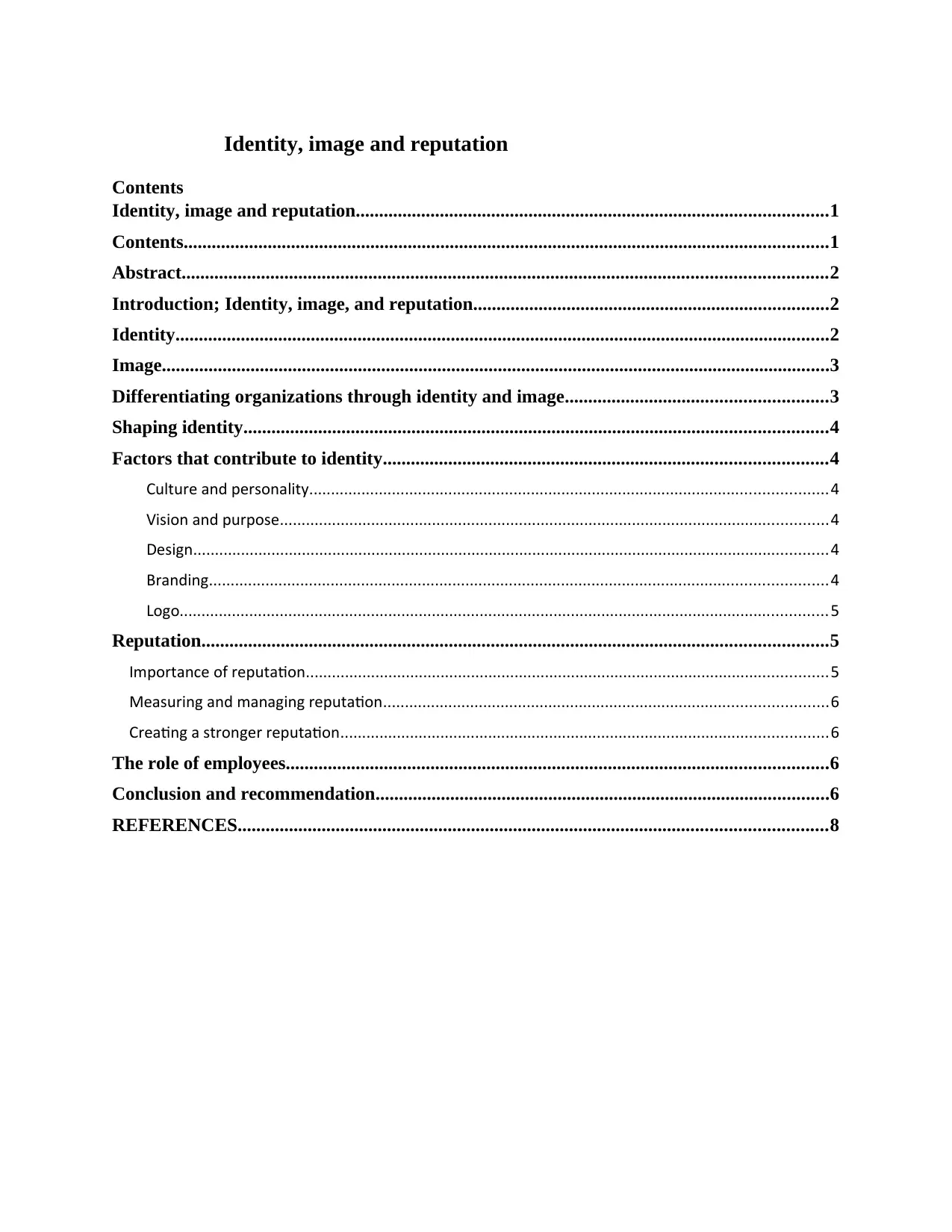
Identity, image and reputation
Contents
Identity, image and reputation.....................................................................................................1
Contents..........................................................................................................................................1
Abstract..........................................................................................................................................2
Introduction; Identity, image, and reputation............................................................................2
Identity............................................................................................................................................2
Image...............................................................................................................................................3
Differentiating organizations through identity and image........................................................3
Shaping identity.............................................................................................................................4
Factors that contribute to identity...............................................................................................4
Culture and personality.......................................................................................................................4
Vision and purpose..............................................................................................................................4
Design..................................................................................................................................................4
Branding..............................................................................................................................................4
Logo.....................................................................................................................................................5
Reputation......................................................................................................................................5
Importance of reputation........................................................................................................................5
Measuring and managing reputation......................................................................................................6
Creating a stronger reputation................................................................................................................6
The role of employees....................................................................................................................6
Conclusion and recommendation.................................................................................................6
REFERENCES..............................................................................................................................8
Contents
Identity, image and reputation.....................................................................................................1
Contents..........................................................................................................................................1
Abstract..........................................................................................................................................2
Introduction; Identity, image, and reputation............................................................................2
Identity............................................................................................................................................2
Image...............................................................................................................................................3
Differentiating organizations through identity and image........................................................3
Shaping identity.............................................................................................................................4
Factors that contribute to identity...............................................................................................4
Culture and personality.......................................................................................................................4
Vision and purpose..............................................................................................................................4
Design..................................................................................................................................................4
Branding..............................................................................................................................................4
Logo.....................................................................................................................................................5
Reputation......................................................................................................................................5
Importance of reputation........................................................................................................................5
Measuring and managing reputation......................................................................................................6
Creating a stronger reputation................................................................................................................6
The role of employees....................................................................................................................6
Conclusion and recommendation.................................................................................................6
REFERENCES..............................................................................................................................8
Paraphrase This Document
Need a fresh take? Get an instant paraphrase of this document with our AI Paraphraser
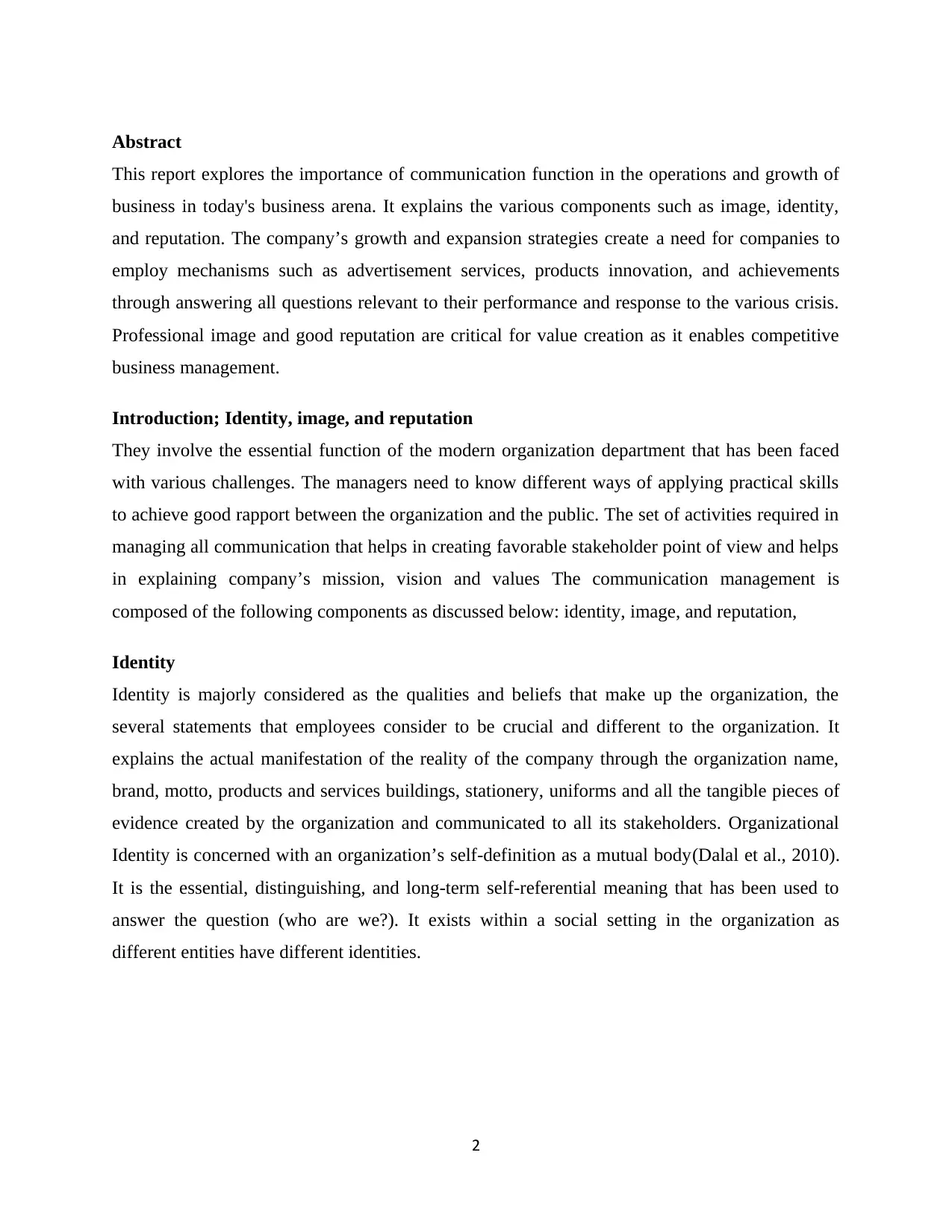
Abstract
This report explores the importance of communication function in the operations and growth of
business in today's business arena. It explains the various components such as image, identity,
and reputation. The company’s growth and expansion strategies create a need for companies to
employ mechanisms such as advertisement services, products innovation, and achievements
through answering all questions relevant to their performance and response to the various crisis.
Professional image and good reputation are critical for value creation as it enables competitive
business management.
Introduction; Identity, image, and reputation
They involve the essential function of the modern organization department that has been faced
with various challenges. The managers need to know different ways of applying practical skills
to achieve good rapport between the organization and the public. The set of activities required in
managing all communication that helps in creating favorable stakeholder point of view and helps
in explaining company’s mission, vision and values The communication management is
composed of the following components as discussed below: identity, image, and reputation,
Identity
Identity is majorly considered as the qualities and beliefs that make up the organization, the
several statements that employees consider to be crucial and different to the organization. It
explains the actual manifestation of the reality of the company through the organization name,
brand, motto, products and services buildings, stationery, uniforms and all the tangible pieces of
evidence created by the organization and communicated to all its stakeholders. Organizational
Identity is concerned with an organization’s self-definition as a mutual body(Dalal et al., 2010).
It is the essential, distinguishing, and long-term self-referential meaning that has been used to
answer the question (who are we?). It exists within a social setting in the organization as
different entities have different identities.
2
This report explores the importance of communication function in the operations and growth of
business in today's business arena. It explains the various components such as image, identity,
and reputation. The company’s growth and expansion strategies create a need for companies to
employ mechanisms such as advertisement services, products innovation, and achievements
through answering all questions relevant to their performance and response to the various crisis.
Professional image and good reputation are critical for value creation as it enables competitive
business management.
Introduction; Identity, image, and reputation
They involve the essential function of the modern organization department that has been faced
with various challenges. The managers need to know different ways of applying practical skills
to achieve good rapport between the organization and the public. The set of activities required in
managing all communication that helps in creating favorable stakeholder point of view and helps
in explaining company’s mission, vision and values The communication management is
composed of the following components as discussed below: identity, image, and reputation,
Identity
Identity is majorly considered as the qualities and beliefs that make up the organization, the
several statements that employees consider to be crucial and different to the organization. It
explains the actual manifestation of the reality of the company through the organization name,
brand, motto, products and services buildings, stationery, uniforms and all the tangible pieces of
evidence created by the organization and communicated to all its stakeholders. Organizational
Identity is concerned with an organization’s self-definition as a mutual body(Dalal et al., 2010).
It is the essential, distinguishing, and long-term self-referential meaning that has been used to
answer the question (who are we?). It exists within a social setting in the organization as
different entities have different identities.
2
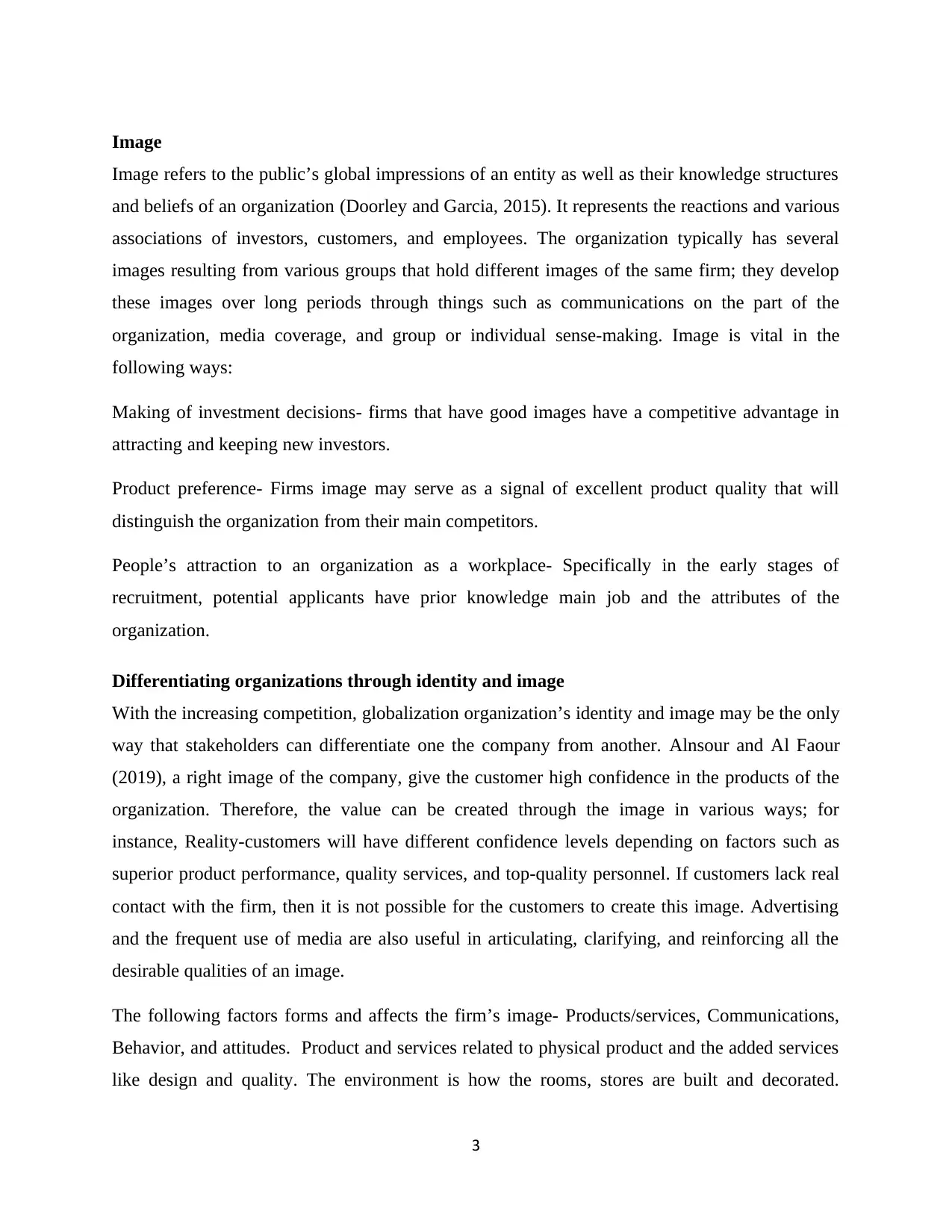
Image
Image refers to the public’s global impressions of an entity as well as their knowledge structures
and beliefs of an organization (Doorley and Garcia, 2015). It represents the reactions and various
associations of investors, customers, and employees. The organization typically has several
images resulting from various groups that hold different images of the same firm; they develop
these images over long periods through things such as communications on the part of the
organization, media coverage, and group or individual sense-making. Image is vital in the
following ways:
Making of investment decisions- firms that have good images have a competitive advantage in
attracting and keeping new investors.
Product preference- Firms image may serve as a signal of excellent product quality that will
distinguish the organization from their main competitors.
People’s attraction to an organization as a workplace- Specifically in the early stages of
recruitment, potential applicants have prior knowledge main job and the attributes of the
organization.
Differentiating organizations through identity and image
With the increasing competition, globalization organization’s identity and image may be the only
way that stakeholders can differentiate one the company from another. Alnsour and Al Faour
(2019), a right image of the company, give the customer high confidence in the products of the
organization. Therefore, the value can be created through the image in various ways; for
instance, Reality-customers will have different confidence levels depending on factors such as
superior product performance, quality services, and top-quality personnel. If customers lack real
contact with the firm, then it is not possible for the customers to create this image. Advertising
and the frequent use of media are also useful in articulating, clarifying, and reinforcing all the
desirable qualities of an image.
The following factors forms and affects the firm’s image- Products/services, Communications,
Behavior, and attitudes. Product and services related to physical product and the added services
like design and quality. The environment is how the rooms, stores are built and decorated.
3
Image refers to the public’s global impressions of an entity as well as their knowledge structures
and beliefs of an organization (Doorley and Garcia, 2015). It represents the reactions and various
associations of investors, customers, and employees. The organization typically has several
images resulting from various groups that hold different images of the same firm; they develop
these images over long periods through things such as communications on the part of the
organization, media coverage, and group or individual sense-making. Image is vital in the
following ways:
Making of investment decisions- firms that have good images have a competitive advantage in
attracting and keeping new investors.
Product preference- Firms image may serve as a signal of excellent product quality that will
distinguish the organization from their main competitors.
People’s attraction to an organization as a workplace- Specifically in the early stages of
recruitment, potential applicants have prior knowledge main job and the attributes of the
organization.
Differentiating organizations through identity and image
With the increasing competition, globalization organization’s identity and image may be the only
way that stakeholders can differentiate one the company from another. Alnsour and Al Faour
(2019), a right image of the company, give the customer high confidence in the products of the
organization. Therefore, the value can be created through the image in various ways; for
instance, Reality-customers will have different confidence levels depending on factors such as
superior product performance, quality services, and top-quality personnel. If customers lack real
contact with the firm, then it is not possible for the customers to create this image. Advertising
and the frequent use of media are also useful in articulating, clarifying, and reinforcing all the
desirable qualities of an image.
The following factors forms and affects the firm’s image- Products/services, Communications,
Behavior, and attitudes. Product and services related to physical product and the added services
like design and quality. The environment is how the rooms, stores are built and decorated.
3
⊘ This is a preview!⊘
Do you want full access?
Subscribe today to unlock all pages.

Trusted by 1+ million students worldwide
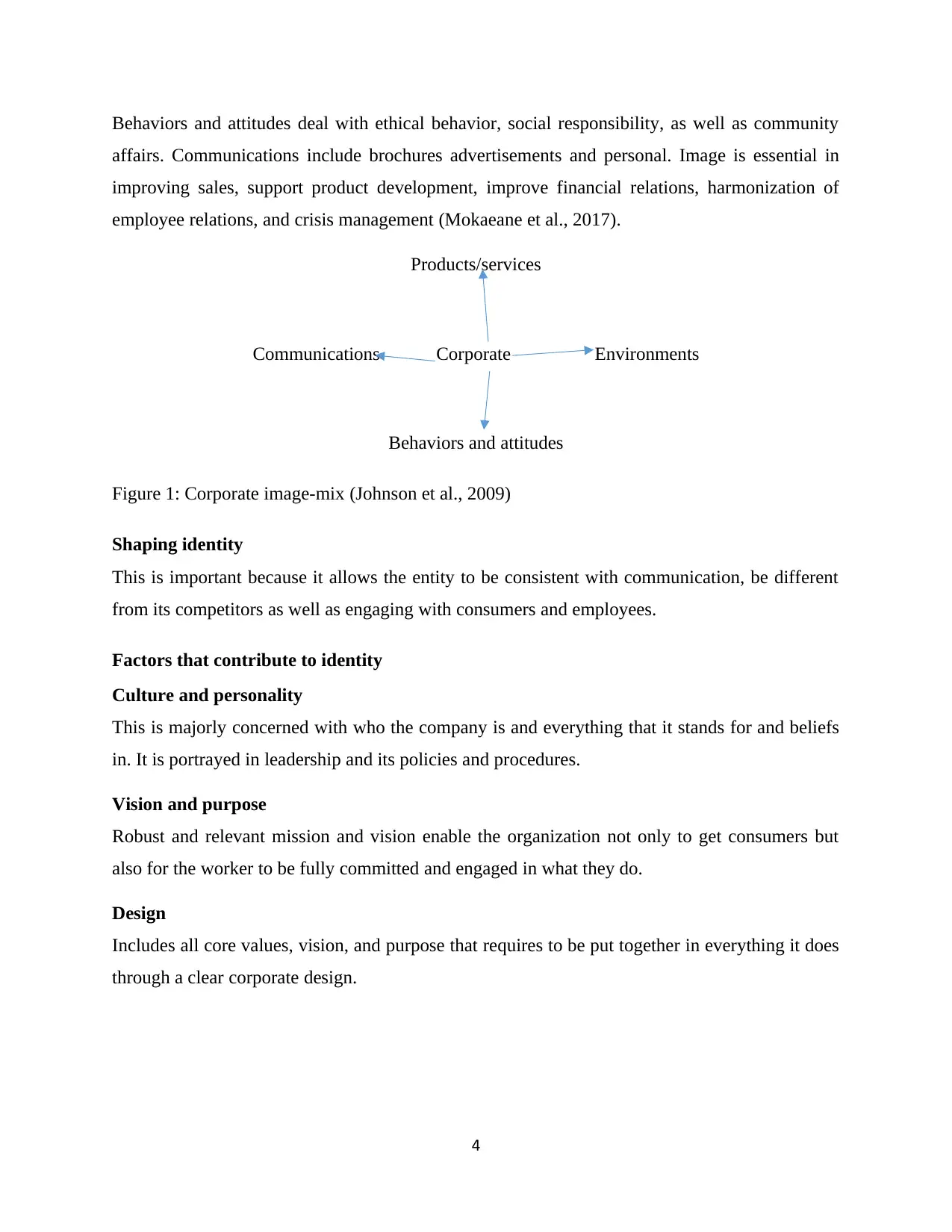
Behaviors and attitudes deal with ethical behavior, social responsibility, as well as community
affairs. Communications include brochures advertisements and personal. Image is essential in
improving sales, support product development, improve financial relations, harmonization of
employee relations, and crisis management (Mokaeane et al., 2017).
Products/services
Communications Corporate Environments
Behaviors and attitudes
Figure 1: Corporate image-mix (Johnson et al., 2009)
Shaping identity
This is important because it allows the entity to be consistent with communication, be different
from its competitors as well as engaging with consumers and employees.
Factors that contribute to identity
Culture and personality
This is majorly concerned with who the company is and everything that it stands for and beliefs
in. It is portrayed in leadership and its policies and procedures.
Vision and purpose
Robust and relevant mission and vision enable the organization not only to get consumers but
also for the worker to be fully committed and engaged in what they do.
Design
Includes all core values, vision, and purpose that requires to be put together in everything it does
through a clear corporate design.
4
affairs. Communications include brochures advertisements and personal. Image is essential in
improving sales, support product development, improve financial relations, harmonization of
employee relations, and crisis management (Mokaeane et al., 2017).
Products/services
Communications Corporate Environments
Behaviors and attitudes
Figure 1: Corporate image-mix (Johnson et al., 2009)
Shaping identity
This is important because it allows the entity to be consistent with communication, be different
from its competitors as well as engaging with consumers and employees.
Factors that contribute to identity
Culture and personality
This is majorly concerned with who the company is and everything that it stands for and beliefs
in. It is portrayed in leadership and its policies and procedures.
Vision and purpose
Robust and relevant mission and vision enable the organization not only to get consumers but
also for the worker to be fully committed and engaged in what they do.
Design
Includes all core values, vision, and purpose that requires to be put together in everything it does
through a clear corporate design.
4
Paraphrase This Document
Need a fresh take? Get an instant paraphrase of this document with our AI Paraphraser
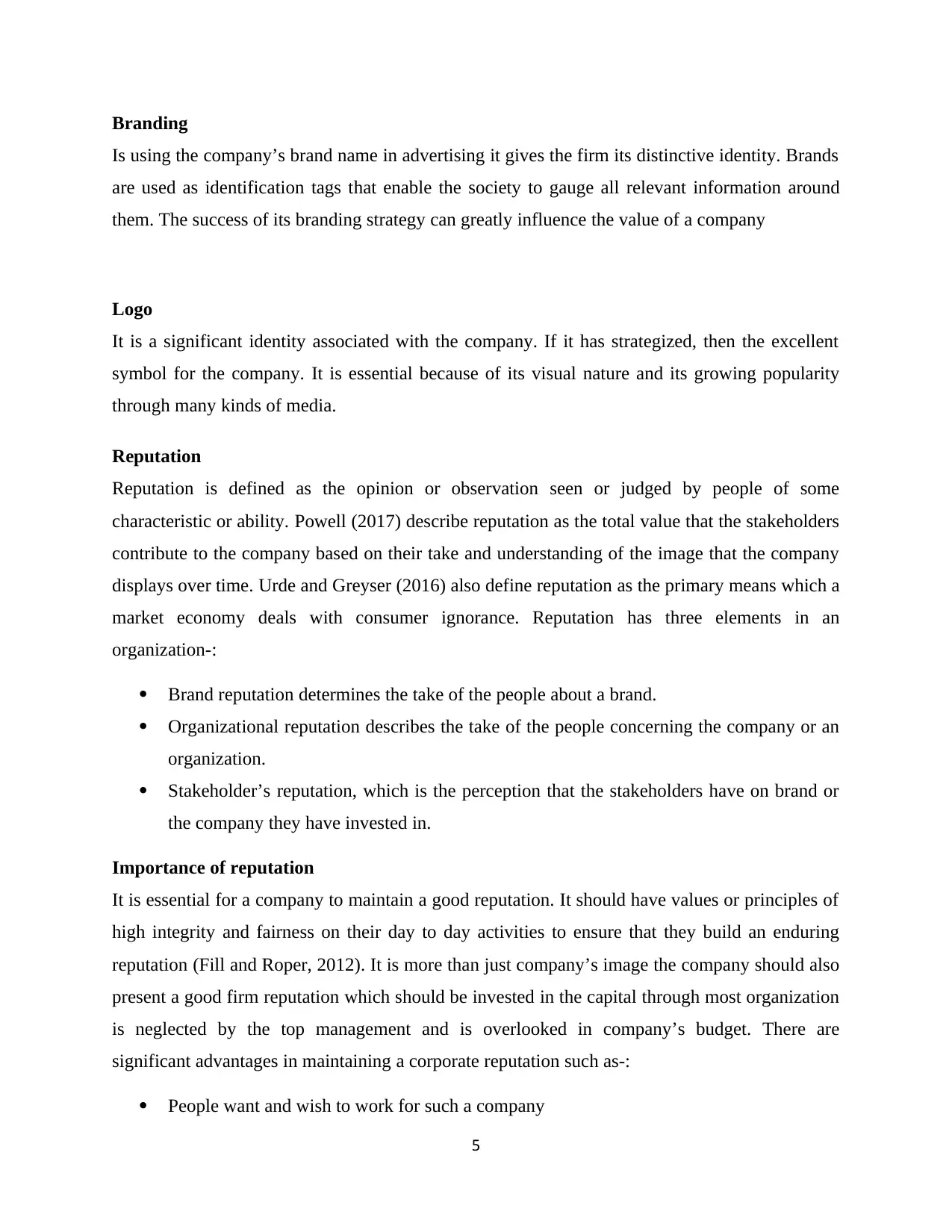
Branding
Is using the company’s brand name in advertising it gives the firm its distinctive identity. Brands
are used as identification tags that enable the society to gauge all relevant information around
them. The success of its branding strategy can greatly influence the value of a company
Logo
It is a significant identity associated with the company. If it has strategized, then the excellent
symbol for the company. It is essential because of its visual nature and its growing popularity
through many kinds of media.
Reputation
Reputation is defined as the opinion or observation seen or judged by people of some
characteristic or ability. Powell (2017) describe reputation as the total value that the stakeholders
contribute to the company based on their take and understanding of the image that the company
displays over time. Urde and Greyser (2016) also define reputation as the primary means which a
market economy deals with consumer ignorance. Reputation has three elements in an
organization-:
Brand reputation determines the take of the people about a brand.
Organizational reputation describes the take of the people concerning the company or an
organization.
Stakeholder’s reputation, which is the perception that the stakeholders have on brand or
the company they have invested in.
Importance of reputation
It is essential for a company to maintain a good reputation. It should have values or principles of
high integrity and fairness on their day to day activities to ensure that they build an enduring
reputation (Fill and Roper, 2012). It is more than just company’s image the company should also
present a good firm reputation which should be invested in the capital through most organization
is neglected by the top management and is overlooked in company’s budget. There are
significant advantages in maintaining a corporate reputation such as-:
People want and wish to work for such a company
5
Is using the company’s brand name in advertising it gives the firm its distinctive identity. Brands
are used as identification tags that enable the society to gauge all relevant information around
them. The success of its branding strategy can greatly influence the value of a company
Logo
It is a significant identity associated with the company. If it has strategized, then the excellent
symbol for the company. It is essential because of its visual nature and its growing popularity
through many kinds of media.
Reputation
Reputation is defined as the opinion or observation seen or judged by people of some
characteristic or ability. Powell (2017) describe reputation as the total value that the stakeholders
contribute to the company based on their take and understanding of the image that the company
displays over time. Urde and Greyser (2016) also define reputation as the primary means which a
market economy deals with consumer ignorance. Reputation has three elements in an
organization-:
Brand reputation determines the take of the people about a brand.
Organizational reputation describes the take of the people concerning the company or an
organization.
Stakeholder’s reputation, which is the perception that the stakeholders have on brand or
the company they have invested in.
Importance of reputation
It is essential for a company to maintain a good reputation. It should have values or principles of
high integrity and fairness on their day to day activities to ensure that they build an enduring
reputation (Fill and Roper, 2012). It is more than just company’s image the company should also
present a good firm reputation which should be invested in the capital through most organization
is neglected by the top management and is overlooked in company’s budget. There are
significant advantages in maintaining a corporate reputation such as-:
People want and wish to work for such a company
5
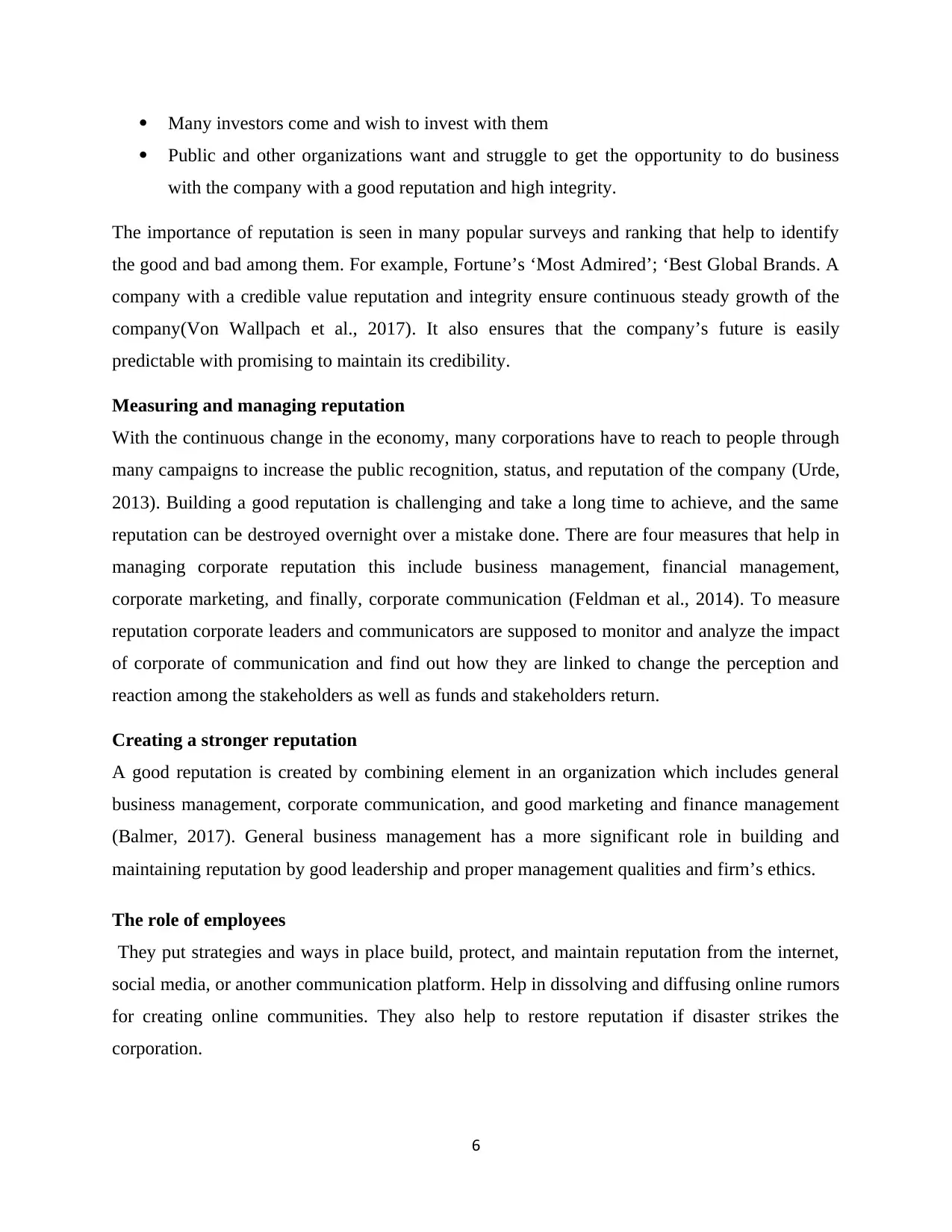
Many investors come and wish to invest with them
Public and other organizations want and struggle to get the opportunity to do business
with the company with a good reputation and high integrity.
The importance of reputation is seen in many popular surveys and ranking that help to identify
the good and bad among them. For example, Fortune’s ‘Most Admired’; ‘Best Global Brands. A
company with a credible value reputation and integrity ensure continuous steady growth of the
company(Von Wallpach et al., 2017). It also ensures that the company’s future is easily
predictable with promising to maintain its credibility.
Measuring and managing reputation
With the continuous change in the economy, many corporations have to reach to people through
many campaigns to increase the public recognition, status, and reputation of the company (Urde,
2013). Building a good reputation is challenging and take a long time to achieve, and the same
reputation can be destroyed overnight over a mistake done. There are four measures that help in
managing corporate reputation this include business management, financial management,
corporate marketing, and finally, corporate communication (Feldman et al., 2014). To measure
reputation corporate leaders and communicators are supposed to monitor and analyze the impact
of corporate of communication and find out how they are linked to change the perception and
reaction among the stakeholders as well as funds and stakeholders return.
Creating a stronger reputation
A good reputation is created by combining element in an organization which includes general
business management, corporate communication, and good marketing and finance management
(Balmer, 2017). General business management has a more significant role in building and
maintaining reputation by good leadership and proper management qualities and firm’s ethics.
The role of employees
They put strategies and ways in place build, protect, and maintain reputation from the internet,
social media, or another communication platform. Help in dissolving and diffusing online rumors
for creating online communities. They also help to restore reputation if disaster strikes the
corporation.
6
Public and other organizations want and struggle to get the opportunity to do business
with the company with a good reputation and high integrity.
The importance of reputation is seen in many popular surveys and ranking that help to identify
the good and bad among them. For example, Fortune’s ‘Most Admired’; ‘Best Global Brands. A
company with a credible value reputation and integrity ensure continuous steady growth of the
company(Von Wallpach et al., 2017). It also ensures that the company’s future is easily
predictable with promising to maintain its credibility.
Measuring and managing reputation
With the continuous change in the economy, many corporations have to reach to people through
many campaigns to increase the public recognition, status, and reputation of the company (Urde,
2013). Building a good reputation is challenging and take a long time to achieve, and the same
reputation can be destroyed overnight over a mistake done. There are four measures that help in
managing corporate reputation this include business management, financial management,
corporate marketing, and finally, corporate communication (Feldman et al., 2014). To measure
reputation corporate leaders and communicators are supposed to monitor and analyze the impact
of corporate of communication and find out how they are linked to change the perception and
reaction among the stakeholders as well as funds and stakeholders return.
Creating a stronger reputation
A good reputation is created by combining element in an organization which includes general
business management, corporate communication, and good marketing and finance management
(Balmer, 2017). General business management has a more significant role in building and
maintaining reputation by good leadership and proper management qualities and firm’s ethics.
The role of employees
They put strategies and ways in place build, protect, and maintain reputation from the internet,
social media, or another communication platform. Help in dissolving and diffusing online rumors
for creating online communities. They also help to restore reputation if disaster strikes the
corporation.
6
⊘ This is a preview!⊘
Do you want full access?
Subscribe today to unlock all pages.

Trusted by 1+ million students worldwide
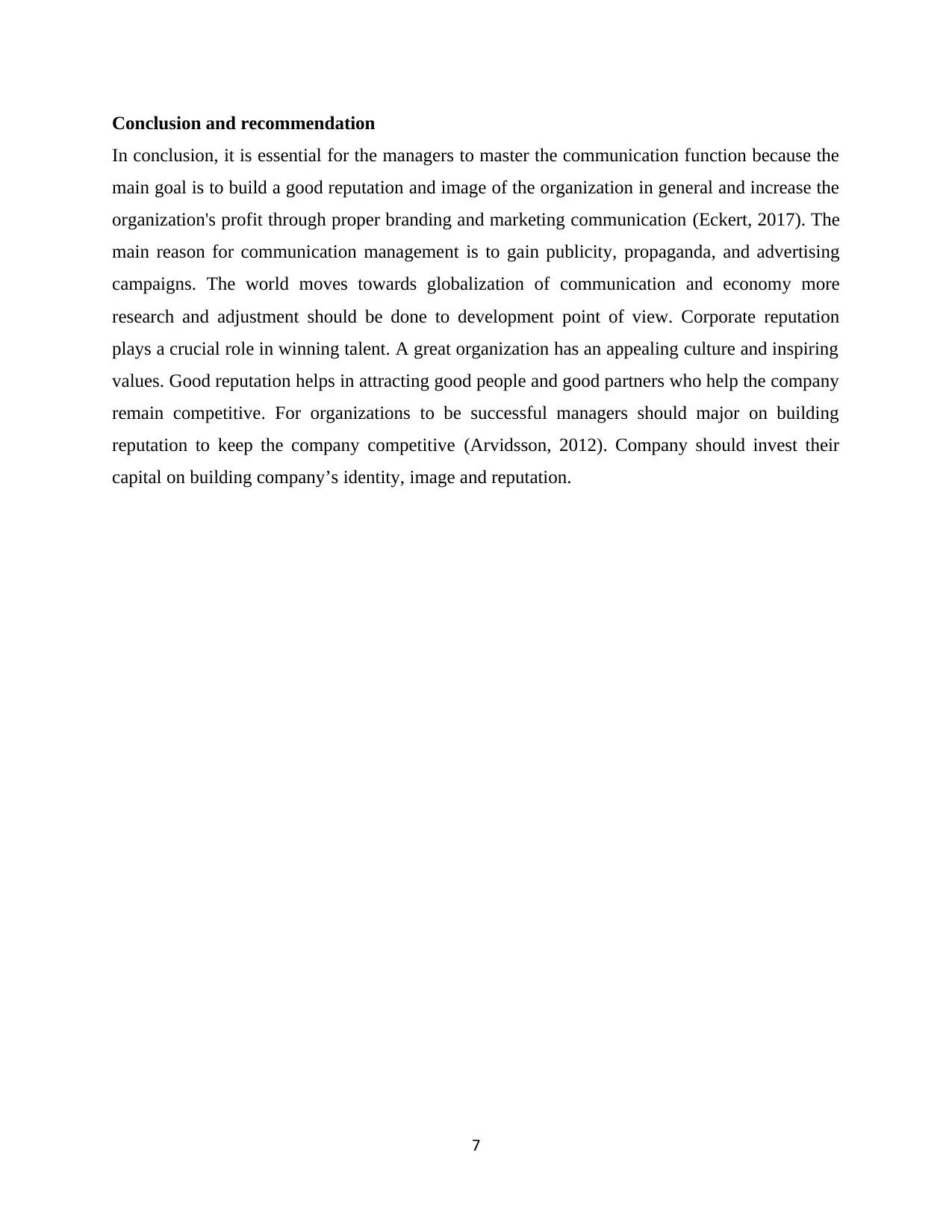
Conclusion and recommendation
In conclusion, it is essential for the managers to master the communication function because the
main goal is to build a good reputation and image of the organization in general and increase the
organization's profit through proper branding and marketing communication (Eckert, 2017). The
main reason for communication management is to gain publicity, propaganda, and advertising
campaigns. The world moves towards globalization of communication and economy more
research and adjustment should be done to development point of view. Corporate reputation
plays a crucial role in winning talent. A great organization has an appealing culture and inspiring
values. Good reputation helps in attracting good people and good partners who help the company
remain competitive. For organizations to be successful managers should major on building
reputation to keep the company competitive (Arvidsson, 2012). Company should invest their
capital on building company’s identity, image and reputation.
7
In conclusion, it is essential for the managers to master the communication function because the
main goal is to build a good reputation and image of the organization in general and increase the
organization's profit through proper branding and marketing communication (Eckert, 2017). The
main reason for communication management is to gain publicity, propaganda, and advertising
campaigns. The world moves towards globalization of communication and economy more
research and adjustment should be done to development point of view. Corporate reputation
plays a crucial role in winning talent. A great organization has an appealing culture and inspiring
values. Good reputation helps in attracting good people and good partners who help the company
remain competitive. For organizations to be successful managers should major on building
reputation to keep the company competitive (Arvidsson, 2012). Company should invest their
capital on building company’s identity, image and reputation.
7
Paraphrase This Document
Need a fresh take? Get an instant paraphrase of this document with our AI Paraphraser
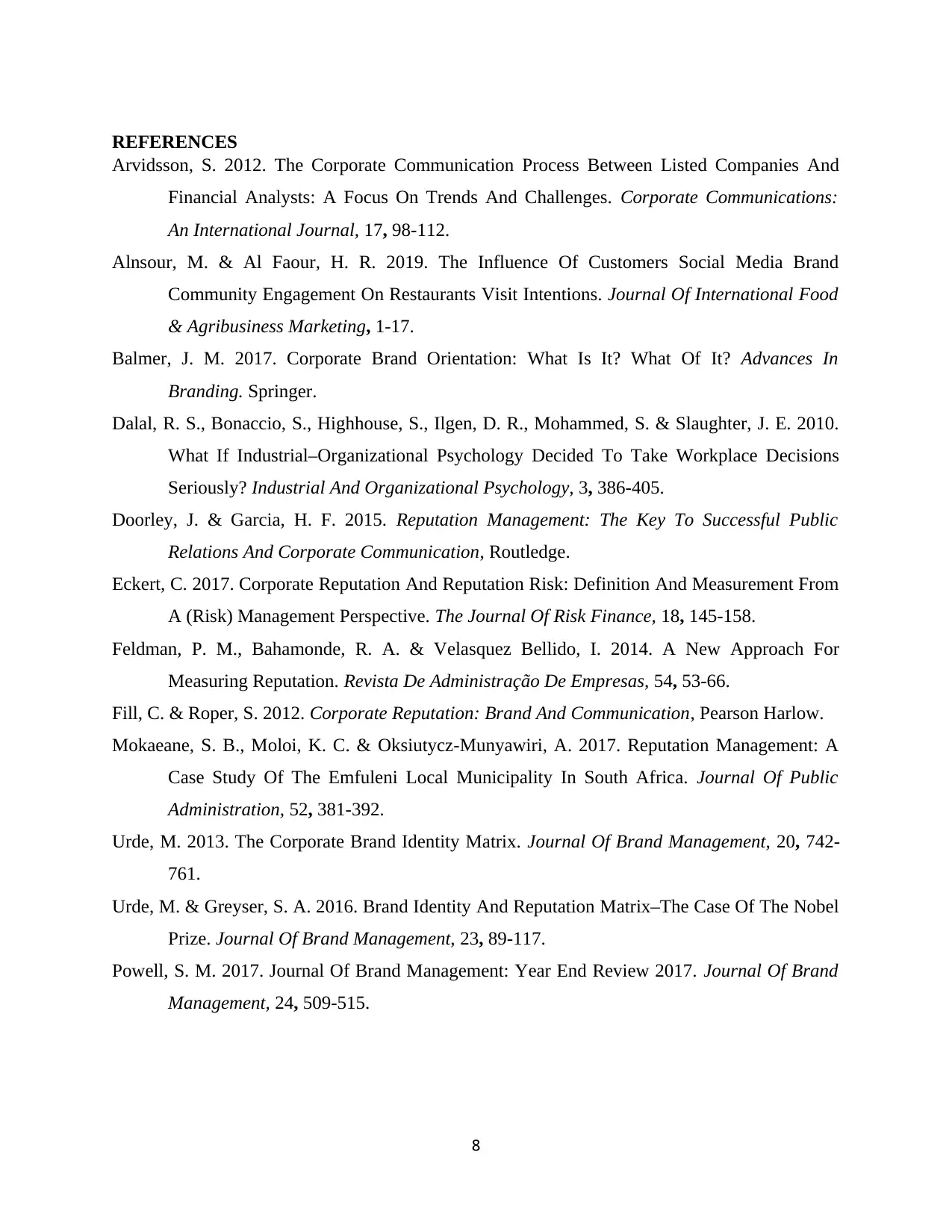
REFERENCES
Arvidsson, S. 2012. The Corporate Communication Process Between Listed Companies And
Financial Analysts: A Focus On Trends And Challenges. Corporate Communications:
An International Journal, 17, 98-112.
Alnsour, M. & Al Faour, H. R. 2019. The Influence Of Customers Social Media Brand
Community Engagement On Restaurants Visit Intentions. Journal Of International Food
& Agribusiness Marketing, 1-17.
Balmer, J. M. 2017. Corporate Brand Orientation: What Is It? What Of It? Advances In
Branding. Springer.
Dalal, R. S., Bonaccio, S., Highhouse, S., Ilgen, D. R., Mohammed, S. & Slaughter, J. E. 2010.
What If Industrial–Organizational Psychology Decided To Take Workplace Decisions
Seriously? Industrial And Organizational Psychology, 3, 386-405.
Doorley, J. & Garcia, H. F. 2015. Reputation Management: The Key To Successful Public
Relations And Corporate Communication, Routledge.
Eckert, C. 2017. Corporate Reputation And Reputation Risk: Definition And Measurement From
A (Risk) Management Perspective. The Journal Of Risk Finance, 18, 145-158.
Feldman, P. M., Bahamonde, R. A. & Velasquez Bellido, I. 2014. A New Approach For
Measuring Reputation. Revista De Administração De Empresas, 54, 53-66.
Fill, C. & Roper, S. 2012. Corporate Reputation: Brand And Communication, Pearson Harlow.
Mokaeane, S. B., Moloi, K. C. & Oksiutycz-Munyawiri, A. 2017. Reputation Management: A
Case Study Of The Emfuleni Local Municipality In South Africa. Journal Of Public
Administration, 52, 381-392.
Urde, M. 2013. The Corporate Brand Identity Matrix. Journal Of Brand Management, 20, 742-
761.
Urde, M. & Greyser, S. A. 2016. Brand Identity And Reputation Matrix–The Case Of The Nobel
Prize. Journal Of Brand Management, 23, 89-117.
Powell, S. M. 2017. Journal Of Brand Management: Year End Review 2017. Journal Of Brand
Management, 24, 509-515.
8
Arvidsson, S. 2012. The Corporate Communication Process Between Listed Companies And
Financial Analysts: A Focus On Trends And Challenges. Corporate Communications:
An International Journal, 17, 98-112.
Alnsour, M. & Al Faour, H. R. 2019. The Influence Of Customers Social Media Brand
Community Engagement On Restaurants Visit Intentions. Journal Of International Food
& Agribusiness Marketing, 1-17.
Balmer, J. M. 2017. Corporate Brand Orientation: What Is It? What Of It? Advances In
Branding. Springer.
Dalal, R. S., Bonaccio, S., Highhouse, S., Ilgen, D. R., Mohammed, S. & Slaughter, J. E. 2010.
What If Industrial–Organizational Psychology Decided To Take Workplace Decisions
Seriously? Industrial And Organizational Psychology, 3, 386-405.
Doorley, J. & Garcia, H. F. 2015. Reputation Management: The Key To Successful Public
Relations And Corporate Communication, Routledge.
Eckert, C. 2017. Corporate Reputation And Reputation Risk: Definition And Measurement From
A (Risk) Management Perspective. The Journal Of Risk Finance, 18, 145-158.
Feldman, P. M., Bahamonde, R. A. & Velasquez Bellido, I. 2014. A New Approach For
Measuring Reputation. Revista De Administração De Empresas, 54, 53-66.
Fill, C. & Roper, S. 2012. Corporate Reputation: Brand And Communication, Pearson Harlow.
Mokaeane, S. B., Moloi, K. C. & Oksiutycz-Munyawiri, A. 2017. Reputation Management: A
Case Study Of The Emfuleni Local Municipality In South Africa. Journal Of Public
Administration, 52, 381-392.
Urde, M. 2013. The Corporate Brand Identity Matrix. Journal Of Brand Management, 20, 742-
761.
Urde, M. & Greyser, S. A. 2016. Brand Identity And Reputation Matrix–The Case Of The Nobel
Prize. Journal Of Brand Management, 23, 89-117.
Powell, S. M. 2017. Journal Of Brand Management: Year End Review 2017. Journal Of Brand
Management, 24, 509-515.
8

Von Wallpach, S., Hemetsberger, A. & Espersen, P. 2017. Performing Identities: Processes Of
Brand And Stakeholder Identity Co-Construction. Journal Of Business Research, 70,
443-452.
9
Brand And Stakeholder Identity Co-Construction. Journal Of Business Research, 70,
443-452.
9
⊘ This is a preview!⊘
Do you want full access?
Subscribe today to unlock all pages.

Trusted by 1+ million students worldwide
1 out of 9
Related Documents
Your All-in-One AI-Powered Toolkit for Academic Success.
+13062052269
info@desklib.com
Available 24*7 on WhatsApp / Email
![[object Object]](/_next/static/media/star-bottom.7253800d.svg)
Unlock your academic potential
Copyright © 2020–2025 A2Z Services. All Rights Reserved. Developed and managed by ZUCOL.





